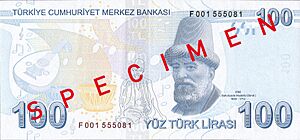Buhurizade Mustafa Itri facts for kids
Mustafa Itri, often called Buhurizade Mustafa Itri, or just Itri (born around 1640, died 1712), was an amazing Ottoman-Turkish musician, composer, singer, and poet. He created over a thousand musical pieces. Even though only about forty of them still exist today, he is known as the master of Turkish classical music. In 2012, to celebrate 300 years since Itri's death, UNESCO named 2012 the "International Itri Year."
About Itri
We don't know everything for sure about Itri's life. His real name was Mustafa. Sometimes people called him Buhurizade Mustafa Efendi. Itri was a very important person in Turkish classical music. He wrote a huge amount of music. Sadly, most of his works are now lost. Only about forty pieces have survived.
His Life and Music
It is thought that Itri was a Mevlevi. This means he was part of a special religious group. He wrote religious music for them. Itri lived during the time of five different Ottoman Sultans. He became very famous when Sultan Mehmet IV was in charge.
Itri sang in special concert programs called fasıls. In these concerts, all the songs used the same musical style, called a makam. He performed for Sultan Mehmet IV. From then on, the palace supported him for many years. He also taught music at the palace's Enderun school. Itri was even interested in gardening! People believe his name, Itri, comes from the word "itir," which means pelargonium (a type of flower).
Itri's Other Talents
Like many composers of his time, Itri was also a well-known poet. He wrote poems in the traditional Ottoman style, called Divan poetry. He also wrote poems that were like folk music and poetry. Sadly, most of his poems are lost today. Itri was also skilled in calligraphy, which is the art of beautiful handwriting.
Itri on Money
Itri's picture is shown on the back of the Turkish 100 lira banknote. This banknote was first made in 2009.
His Music
Itri composed many different kinds of music. He wrote religious pieces, like the "Segâh Kurban Bayramı Tekbiri" and "Segâh Salât-ı Ümmiye." He also created longer musical works called "Beste" and "Semai" in various makams. These included pieces like "Nevâ Kâr" and "Rast Darb-ı Türkî Naat." His works are still important examples of Ottoman classical music today.


